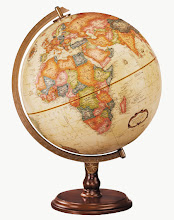 Joshua didn't conquer Beth-shan, and there is still evidence of the Egyptian governor's palace on the tel. When the Romans conquered the city, they built their city at the base of the hill, which had simply become too high, and renamed it Scythopolis. The city was destroyed by an earthquake in 749 AD. Only the public areas have been excavated and restored, the surrounding houses are still buried. We had fun exploring the area - the large bathhouse, the theatre, and of course, the public toilets where everyone sits down together in a row.
Joshua didn't conquer Beth-shan, and there is still evidence of the Egyptian governor's palace on the tel. When the Romans conquered the city, they built their city at the base of the hill, which had simply become too high, and renamed it Scythopolis. The city was destroyed by an earthquake in 749 AD. Only the public areas have been excavated and restored, the surrounding houses are still buried. We had fun exploring the area - the large bathhouse, the theatre, and of course, the public toilets where everyone sits down together in a row.
Continuing up the Harod Valley, we reached Jezreel, the second capital of the Northern Kingdom. From this vantage point, you can see from the Jordan River in the east to the Kishon Pass, leading to the Mediterranean, in the west, and therefore the whole valley and the valuable trade route that runs through it can be controlled from this city. Jezreel was probably used as a winter palace, since it isn't as cold in this area as in Samaria. It's just outside of Jezreel that Ahab takes Naboth's vineyard from him. He wanted to convert Naboth's vineyard into a vegetable garden, which would make the land more valuable and also show off the King's status. Gardens require more water than a vineyard, meaning that it must have been close to the spring in Jezreel, which Ahab would have had control over. (The vineyard was probably close to the clump of trees in the valley on the right side of the picture.)

We tried to have lunch at the Gihon Spring, where Gideon sorted his men before battle, but there were so many mosquitos that we fled to a hill beside Zippori, our next stop.

Herod Antipus was rebuilding Zippori in the time of Jesus, and it's likely that Joseph worked on the site. The word used to describe Joseph's occupation is "tecton", meaning not only carpenter, but also mason; he was probably more like today's general contractor. There are a few well preserved mosaic floors, but there's nothing too exciting about the ruins. From the roof of a Byzantine tower, we were able to look across the valley to Cana, where Jesus did his first miracle, turning water into wine at a wedding. The wedding took place on the third day - Tuesday - which is still seen by Jews to be a good day to get married. That is because, during creation, God said "It was good" twice on that day and on the sixth day (but a wedding on Friday would interfere with the Sabbath day rest), but only once on the other days.

Our final stop in the Galilee was at Beth Shavim to explore the tombs of some famous rabbinical families. The tombs were carved into the hill and contain rooms filled with large, stone ossuaries. It was interesting to see the size of these tombs and the small entryways to get in. The stone door used to seal the tomb was still referred to as a "rolling stone", just like the one that closed Jesus' tomb.


We had some issues getting back into Jerusalem with the bus. June 1 is Jerusalem day, where Jewish Israelis march into Jerusalem to celebrate the reunification of the city and declare their intent to never let it be divided again, causing several roads to be closed, but the list of closed roads isn't released due to security reasons. They like to march through the Arab sections of the city, which obviously leads to tension, so there was extra security throughout the city. We were dropped off a few blocks north of Damascus gate (the closet the bus could get us to the city), so we had a 15 minute walk back to the hotel - I'm happy I had my travel backpack and not a suitcase that had to be pulled down the bumpy stone streets!



No comments:
Post a Comment